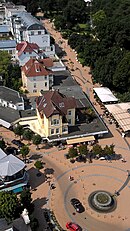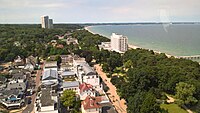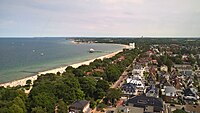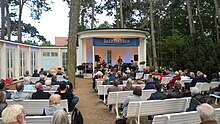Timmendorfer beach
| coat of arms | Germany map | |
|---|---|---|

|
Coordinates: 54 ° 0 ' N , 10 ° 47' E |
|
| Basic data | ||
| State : | Schleswig-Holstein | |
| Circle : | Ostholstein | |
| Height : | 2 m above sea level NHN | |
| Area : | 20.13 km 2 | |
| Residents: | 8712 (Dec. 31, 2019) | |
| Population density : | 433 inhabitants per km 2 | |
| Postal code : | 23669 | |
| Area code : | 04503 | |
| License plate : | OH | |
| Community key : | 01 0 55 042 | |
| Address of the municipal administration: |
Strandallee 42 23669 Timmendorfer Strand |
|
| Website : | ||
| Mayor : | Robert Wagner (independent) | |
| Location of the municipality of Timmendorfer Strand in the Ostholstein district | ||
Timmendorfer Strand is a municipality in the Ostholstein district in Schleswig-Holstein . In addition to the main town, there are the two villages Groß Timmendorf with the residential areas Groß Timmendorf and Oeverdiek as well as Hemmelsdorf with the residential areas Hemmelsdorf, Hainholz and Nothweg. The district of Niendorf also belongs to the community .
As a German seaside resort , Timmendorfer Strand today has around 1,500,000 overnight stays per year and is one of the most fashionable Baltic Sea resorts with a large tourist offer.
geography
The community of Timmendorfer Strand is located 15 kilometers north of Lübeck directly on the Baltic Sea coast. Neighboring communities are Scharbeutz in the north, Ratekau in the south and west and Lübeck - with the Travemünde district - in the east. The beach on the Bay of Lübeck is 6.5 kilometers long. The landscape around Timmendorfer Strand is shaped by the ground moraines of the last Ice Age. The deposits of the Vistula Ice Age created a varied, slightly hilly relief with many lakes. The delightful Hemmelsdorfer See emerged from a fjord cut off from the Baltic Sea . At its bottom, at 39.6 meters below sea level, is the deepest naturally created point in Germany. Another typical feature of the landscape to Timmendorfer beach are under nature conservation standing Knicks .
history

The first mentioned places of the municipality of Timmendorfer Strand are Klein Timmendorf (1260), Groß Timmendorf (1371 sale of the village to two Lübeck citizens) and Niendorf (1385 entry in the Lübeck city book) called Nyendrope (New Village). Earlier traces of settlement can be seen in the cemetery of Groß Timmendorf .
Klein Timmendorf is known as Tymmendroper and also as Wendisch Tymmendorff , as it was inhabited by Wends at the time of settlement by the Germans . Groß Timmendorf was probably founded and inhabited by German settlers. The name "Timmendorf" was probably derived from a German settler of the place with the name Timmo (a German). Timmo and Timm were common names in the Middle Ages .
A map of Rodenberg from 1877/78 (in) shows the places Klein Timmendorf, approx. 1.5 km, and Groß Timmendorf, approx. 2.5 km west of the Baltic Sea beach. Only a few settlements - surrounded by fields - can be seen in the coastal area.
The Ostseebad Niendorf developed organically from the long existing village located directly on the Baltic Sea beach. It has been a state-approved seaside spa since 1954.
Timmendorfer Strand developed around 1880 from individual settlements on the beach to a pure seaside resort. The different developments in the places shaped different mentalities, the rural in Niendorf and urban in Timmendorfer Strand, which have continued to this day.
Klein Timmendorf, which is west of the "Bäderstraße" (Bundesstraße 76) from Timmendorfer Strand, grew up with Timmendorfer Strand and was absorbed into it. The street names Hauptstraße, Mühlenstraße and Schmiedestraße still point to the old town center of Klein Timmendorf. Groß Timmendorf with his name still exists today.
The seaside resort of Timmendorfer Strand was created through the construction of several hotels and guesthouses between 1888 and 1900 along the beach. This also includes the Grisebach and Gropius villas built by the Berlin architect Hans Grisebach around 1888 and 1892, which still exist today and are under monument protection .
In the center of Timmendorfer Strand (Timmendorfer Platz) the “Olgaheim” was built in 1896 as a recreation center for “poor and weak children” (see architectural drawing of the Olgaheim in). From 1946 it was the seat of the municipality's town hall. In 1997 the building was torn down and rebuilt according to the old plans - regarding the facade. Today the spa administration and the library are located here.
By the First World War , Timmendorfer Strand developed into a seaside resort according to the standards of the time with the construction of guesthouses, hotels and private houses. In 1911 there were already around 130 owners of hotels, guest houses, inns and private buildings.
After the war, further development progressed rapidly, the "first row" to the beach was quickly closed with built-up land. In the center of Timmendorfer Strand you can still see guest houses and villas from the early days. Until 1918, Timmendorfer Strand belonged to the Principality of Lübeck , then to the Free State of Oldenburg -Luebeck. With the Greater Hamburg Law of 1937, this part of the country was incorporated into the Prussian province of Schleswig-Holstein as the Eutin district.
At the time of National Socialism , a Kdf -seebad was to be built in Timmendorfer Strand . However, these plans were never implemented. In 1942 a British plane dropped bombs on Niendorf. It is unknown whether it was an emergency drop. The last duds were eliminated in 1962. From 1943 to 1950 the Dervish cigarette factory was in the Niendorf part of the municipality. From 1944 onwards, the administration of the small combat units of the Kriegsmarine was located in the municipality of Timmendorf under the cover name “Strandkoppel” .
When the ships Cap Arcona and Thielbek were sunk in the Lübeck Bay in front of Neustadt , around 7,000 inmates of Neuengamme concentration camp were killed before the end of the war in 1945 . The roughly 800 bodies washed ashore in Timmendorfer Strand were buried in the community's “forest cemetery”.
The municipality of Timmendorfer Strand was formed in 1945 by the British military government from Groß Timmendorf, Klein Timmendorf, Hemmelsdorf (until 1650 Hemmyngestorp) and Niendorf - until then part of the municipality of Ratekau . Pascalides, a Greek from Niendorf, became the first mayor. The community remained part of the Eutin district and thus part of the (formal) Prussian province, from which the state of Schleswig-Holstein was to emerge on August 23, 1946. As a result of the district reform of 1970, the Eutin district was combined with the Oldenburg in Holstein district to form the new Ostholstein district with the district administration in Eutin .
In 1951, Timmendorfer Strand was recognized as a Baltic Sea spa . A number of new buildings were built for the spa operation, in 1952 the drinking spa hall, which was planned by the architect Erich zu Putlitz in the 1930s (it was renovated in 1986), in 1970 the Curschmann Clinic as a rehabilitation clinic for cardiovascular diseases, 1984 the congress house and the ice and tennis center ETC, 1991 the new spa center.
Religion and memorial
At the edge of the chamber forest of Timmendorfer Strand is the Protestant "forest church". In 1912 the still quite small forest chapel was built. In 1964 it was enlarged and received a 23 meter high, slender bell tower.
On the grounds of the forest cemetery on the B 76 there is an old chapel and a new building built in the 1980s. A memorial for the 810 dead of the Cap Arcona tragedy was built across from the old chapel .
A Catholic church is centrally located on Poststrasse.
In the municipality of Niendorf there is a women's convent on the outskirts. In the center of the village is the Protestant "Petri Church", which was built in 1898 by Lübeck architect Schaumann in the neo-Romanesque style. With the increased influx of summer guests to Niendorf at the end of the 19th century, there was also an increasing need for religious support.
politics
Community representation
The municipal elections on May 6, 2018 led to the following result:
coat of arms
Blazon : “In blue a single-masted golden sailing ship with fore and main sail and rudder. In the upper right corner a golden seahorse. "
Town twinning
- Sponsored community : Międzyzdroje (Misdroy), West Pomeranian Voivodeship, Poland, since June 8, 1956 (sponsorship certificate from May 26, 1957)
- Sponsored city: Okonek (Ratzebuhr), Greater Poland Voivodeship, Poland, since July 12, 1956 (sponsorship certificate from August 19, 1956)
- Twin town : Ebeltoft , Denmark, since April 12, 1996
- Joint projects: The municipality runs the Ski, Fun and Sun campaign with the Davos ski resort .
Economy and Infrastructure
As a health resort, the economy in Timmendorfer Strand lives mainly from tourism . There is no significant manufacturing trade or industry apart from one large food-producing company.
An average of 180,000 guests travel to Timmendorfer Strand every year. In 2003 there were 202,000 arrivals, in 2005 there were 196,000. The proportion of foreign guests is between 1 and 2%, the average length of stay is 4.6 days. With 1.5 million overnight stays per year, Timmendorfer Strand is one of the best in the region. Most of the guests come from North Rhine-Westphalia (37.4%) and Lower Saxony (18.23%).
port
The small municipal port is located in the Niendorf part of the municipality. The Aalbek , a connection between the Hemmelsdorfer See and the Baltic Sea, ends here . The Niendorfer Hafen is one of the smallest ports on the Schleswig-Holstein Baltic Sea coast. Built in 1920, the commercial use of the port changed over the decades. Originally planned as a pure fishing port, over the years more and more businesses have settled here, including the Evers shipyard. Between 2005 and 2006 the port was completely renovated and redesigned.
The use of the port has changed significantly over the past few decades. The shipyard was converted into a marina and small businesses such as a boat engine specialist, a sailing school, a boat builder specializing in classic wooden boat construction and restaurants moved into the vacant buildings. Most of the boats today are pleasure craft . One branch of industry is passenger shipping, which still takes place regularly in Niendorf.
traffic
The place is connected to the federal motorway 1 (junction Ratekau , Timmendorfer Strand) and the federal road 76 ( Eutin - Lübeck-Travemünde ).
Timmendorfer Strand can be reached by train via the Lübeck – Puttgarden route, which is part of the Vogelfluglinie . Until 1974 was Niendorf end point of a branch line of the railway line Luebeck-Travemuende beach . An Intercity Express multiple unit ( number 105 ) of the ICE 1 series 401 is named after the municipality .
Bus routes run from Lübeck, Scharbeutz, Lübeck-Travemünde and other nearby places to Timmendorfer Strand.
There are several mooring options for excursion boats in Timmendorfer Strand and Niendorf.
The place is connected to the Baltic Sea Cycle Route , which leads around the Baltic Sea within the European EuroVelo network.
Culture
education
Each part of the municipality of Timmendorfer Strand had its own elementary school. Due to the falling number of pupils, the primary schools were reduced to the Timmendorfer Strand and Niendorf locations. There is also a community school in Timmendorfer Strand (formerly Hauptschule and Realschule, then a regional school).
At the end of the village in the direction of Scharbeutz is the Ostsee-Gymnasium Timmendorfer Strand, founded in 1946 . The Bugenhagen vocational training center, named after the reformer Johannes Bugenhagen, is located near the grammar school . It offers mentally and physically handicapped people the opportunity to find a career and training opportunities. Until 1978, the Bugenhagen boarding school of the Evangelical Lutheran Church was located here, whose students attended the Baltic Sea High School.
JazzBaltica
JazzBaltica is a jazz festival in Schleswig-Holstein that has been taking place since 1991. It was founded with the aim of promoting cultural cooperation between the countries bordering the Baltic Sea by bringing together musicians and especially young talents in changing line-ups. Until 2011 this was the central event location Gut Salzau in the Plön district . Since 2012 the festival has been a guest on the grounds of the Evers shipyard in Timmendorfer Strand-Niendorf. JazzBaltica has been taking place in the New Kurpark in Timmendorfer Strand since 2018.
Sports
- EHC Timmendorfer Strand 06 is the only active ice hockey club in Schleswig-Holstein and is based in the ice sports and tennis center . In 2013 the team was the season winner of the Oberliga Nord.
- German beach volleyball championships have been held every year since 1993 in Timmendorfer Strand at the Maritim Seebrücke in the Ahmann-Hager-Arena that was set up especially for the event .
- Beach Polo has been held in Timmendorfer Strand at the Maritim Seebrücke since 2007.
- 2 golf courses with 18 holes each.
Sights and leisure activities
- Ostseetherme
- Sea Life Center (marine aquarium with local fish)
- Vogelpark Niendorf (with the largest collection of owls in the world)
- Fishing and yacht harbor Niendorf (see Niendorfer Hafen )
- Windmill Timmendorfer Strand from 1846 is a Dutch mill without blades (Mühlenweg 3, west of Bäderstrasse / B 76).
- Sculpture for Udo Lindenberg at the Timmendorfer Seebrücke by the artist Dieter Portugall, installed on April 13, 2012
Seeschlösschenbrücke
The old Seeschlösschenbrücke was replaced from 2010 to 2011 by a 150 meter long pier in the same place. There is a jetty to the side. The client was the municipality of Timmendorfer Strand and the planning of the bridge was carried out by Sellhorn Ingenieurgesellschaft. The cost was around 1.5 million euros. At the bridgehead a 36 by 16 meter platform was erected on which a building in the shape of a pagoda was erected. Parts of the floor are made of glass and allow a view of the sea below. The Mikado tea house was designed, planned and realized by the Hamburg architect Andreas Schuberth. The construction costs amounted to around 1.8 million euros. It opened in July 2014 and was initially intended to serve as a gallery, now it houses the “Wolkenlos” restaurant. On October 19, 2017, the municipality announced that there were significant construction defects on the glass front of the building, which it will likely have to spend another € 800,000 to repair.
Old spa park
In the Timmendorfer Strand part of the municipality, a spa park with an open-air stage was created in the 1930s . In addition to a mini golf course and a large chess board, the Kurmittelhaus was built in 1994. In 2006, work began on the complete renovation. The plan was to restore the park to its 1930s state. In 2013 the orphaned Kurmittelhaus was only used on Thursday to distribute food to the Timmendorfer in need, the neighboring open-air stage was demolished, and renovation work on the spa park has not yet taken place. The spa park has lost area and several older trees in favor of a cycle path along the mountain road.
New spa park
The New Kurpark is located in the center of Timmendorfer Strand between the spa and beach promenade. The new spa park houses the seahorse fountain and the drinking spa hall , which has been a listed monument since 1989 and is used as an event location all year round.
Personalities
- Martin Gropius (1824–1880), architect of historicism , great-uncle of Walter Gropius.
- Hans Grisebach (1848–1904), Berlin architect, owns the Villa Grisebach on Strandallee, which he built in 1892 next to Villa Gropius (1888). Both villas still exist today and are listed buildings .
- Walter (secret building officer) and Manon Gropius, parents of Walter Gropius.
- Walter Gropius (1883–1969), architect and founder of the Bauhaus . The Gropius family inherited from Auguste Wahllaender, the great-aunt of Walter Gropius, the Villa Gropius, which they owned until the 1930s.
- Hermann Löns (1866–1914), journalist and writer, lived in Niendorf for some time. In 1985, a 14 m high observation tower was built in honor of the writer on the northeastern bank of the Hemmelsdorf lake .
- William von Simpson (1881-1945), writer, wrote, among other things, The Barrings , for which it took him 20 years. He is buried in the community cemetery.
- Erich Dummer (1889–1929), painter, in the spring of 1921 spent several weeks in Timmendorfer Strand.
- Paul Binus (1901–1981), politician ( NSDAP ) and SA leader, died in Niendorf.
- Horst-Günter Benkmann (1915–1996), was a German lawyer and East Prussian historical author.
- Marcel Reich-Ranicki (1920–2013), Polish-German publicist, for decades he and his wife were summer guests in Timmendorfer Strand.
- Hans Bierbrauer (1922–2006) alias Oskar , caricaturist and painter, lived temporarily in Timmendorfer Strand.
- Ingeburg Herz (1920–2015), widow of Tchibo founder Max Herz , who died in 1965 , lived in Timmendorfer Strand.
- Leila Negra (* 1930) lived in Timmendorfer Strand for the first few years after the Second World War, where she was discovered.
- Günter Willumeit (1941–2013), entertainer and dentist, became known as the farmer Piepenbrink , lived for a time in Niendorf.
- Volkert Kraeft (* 1941), actor.
- Jürgen Hunke (* 1943), entrepreneur, book author, sports official, politician, publisher and theater owner. He owns three Asian-style houses in Timmendorfer Strand and runs a bookshop for Asian literature in the historic reading hall (built in 1913) on the promenade.
- Norbert Cobabus (1944–2013), librarian and private scholar
- Gunter Gebauer (* 1944), writer and philosopher.
- Friedemann Schulz (1945–2016) was a German radio play and screenwriter.
- Sylvia Eisenberg (* 1948), member of the CDU state parliament.
- Gert Maichel (* 1949), CEO Multi Energy at RWE AG, CEO of RWE Power AG, President of the German Atomic Forum .
- Hans-Hermann Dubben (* 1955), physicist, winner of the Fischer-Appelt (1996) and Hermann-Holthusen (2000) awards .
- Schorsch Cameroon (* 1963), actually Thomas Sehl, singer ( Die Goldenen Zitronen ), author and director.
- Sven Unterwaldt (* 1965), screenwriter and film director ( 7 dwarfs with Otto Waalkes , among others ), grew up in Timmendorfer Strand and attended the Ostsee-Gymnasium there.
- Thorben Saggau (* 1987) is a German ice hockey player.
literature
- Otto Rönnpag: A new community emerges - Timmendorfer Strand 1945 . In: Jahrbuch für Heimatkunde . Struve's Buchdruckerei und Verlag, Eutin 1987, pp. 150-154
- Heiner Herde: Timmendorfer Strand (The series archive images). Sutton-Verlag, Erfurt 2006, ISBN 3-89702-985-5
Web links
Individual evidence
- ↑ North Statistics Office - Population of the municipalities in Schleswig-Holstein 4th quarter 2019 (XLSX file) (update based on the 2011 census) ( help on this ).
- ↑ a b c Schleswig-Holstein topography. Vol. 10: Timmaspe - Ziethen . 1st edition Flying-Kiwi-Verl. Junge, Flensburg 2008, ISBN 978-3-926055-92-7 , p. 4 ( dnb.de [accessed on August 6, 2020]).
- ^ A b Community Timmendorfer Strand: Life in the community - historical development. In: timmendorfer-strand.org. August 1, 2024, accessed February 16, 2019 .
- ↑ Volker Böder: Where is the lowest point in Germany? scinexx.de of October 26, 2007, accessed on January 3, 2019
- ↑ a b c d Chronicle of the bath community Timmendorfer Strand - For the centenary 1965. Second expanded edition. Municipality of Timmendorfer Strand, 1979, DNB 800849078 .
- ^ A b c Georg Schipporeit: Timmendorfer Strand and Niendorf / Baltic Sea . Verlag Gronenberg, Wiehl 2002, ISBN 3-88265-234-9 .
- ↑ a b List of Monuments Ostholstein , Schleswig-Holstein, State Office for Monument Preservation, March 18, 2019 (pages 192/204), accessed on May 11, 2019.
- ^ A b c Heiner Herde: Timmendorfer Strand Google Books
- ↑ Heiner Herde: Ostseebad Timmendorfer Strand: A journey through time in pictures Google Books
- ↑ Reparations: Shut up. Der Spiegel 43/1952, accessed on May 11, 2016
- ^ Community of Timmendorfer Strand: Life in the community - data and facts. In: timmendorfer-strand.org. July 1, 1992, accessed February 16, 2019 .
- ^ Forest Church, Ev.-Luth. Timmendorfer Strand parish
- ↑ Information board in the "Waldkirche".
- ^ Petri Church - Church history
- ↑ Schleswig-Holstein's municipal coat of arms
- ↑ Baltic Sea Cycle Route - Baltic Sea Schleswig Holstein. Retrieved May 6, 2017 .
- ↑ translator2: EuroVelo 10 - EuroVelo. Retrieved May 6, 2017 .
- ↑ a b Timmendorfer Strand - sports facilities
- ↑ Windmühle Timmendorfer Strand , German Society for Milling Knowledge and Mill Conservation (DGM) e. V.
- ↑ Windmühle, Timmendorfer Strand (renovation object) ( Memento of the original from March 4, 2016 in the Internet Archive ) Info: The archive link was inserted automatically and has not yet been checked. Please check the original and archive link according to the instructions and then remove this notice.
- ↑ Beach view, crowds at the Maritim: Udo Lindenberg reveals the "horizon".
- ↑ Seeschlößchenbrücke, Timmendorfer Strand.
- ↑ Lübecker Nachrichten, Lübeck, Schleswig-Holstein, Germany: It'll be an expensive cup of tea. Retrieved January 1, 2018 .
- ↑ Trinkkurhalle
- ↑ Hermann-Löns-Blick ( Memento of the original from September 24, 2015 in the Internet Archive ) Info: The archive link was inserted automatically and has not yet been checked. Please check the original and archive link according to the instructions and then remove this notice.
- ^ The Critic of the Germans In: Der Spiegel , September 21, 2013





























